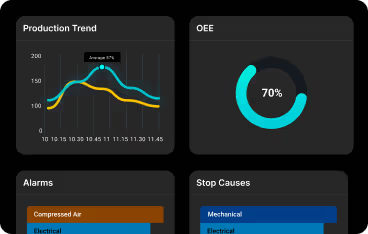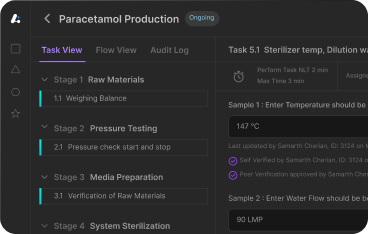Top FDA 483 Observations in Batch Manufacturing
Analyze top FDA 483 observations in batch manufacturing, including root causes, corrective actions, and preventive measures to ensure compliance.


Introduction: Why FDA 483 Observations in Batch Manufacturing Matter
In the tightly regulated world of pharmaceutical manufacturing, compliance is not just a box to tick—it’s the backbone of product quality, patient safety, and business continuity. Among the many regulatory oversight mechanisms, the FDA Form 483 stands out as a critical document that signals gaps in Good Manufacturing Practices (GMP).
When the U.S. Food and Drug Administration (FDA) conducts inspections and issues a Form 483, it highlights potential violations that could impact product quality, process reliability, and ultimately, patient safety. FDA inspections play a critical role in ensuring compliance and maintaining quality standards in the pharmaceutical industry. For Quality leaders, Manufacturing Heads, and Compliance Executives, these observations are more than inspection notes—they are operational and reputational risks.
Engaging with the FDA inspector to clarify concerns during inspections is crucial for addressing potential non-compliance issues effectively.
Batch manufacturing, the core of pharmaceutical production, is often where compliance breaks down—from inadequate area separation and improper documentation to unqualified equipment and lack of oversight in weighing and mixing. Each observation has the potential to snowball into warning letters, import alerts, or even consent decrees if not addressed swiftly and systematically.
This article dives deep into the most frequent FDA 483 observations in batch manufacturing, analyzing real inspection data, identifying root causes, and offering actionable strategies to stay audit-ready. Whether you’re preparing for an upcoming inspection or trying to improve your compliance program, these insights will help you take proactive steps. 💡 Pro Tip: Track, analyze, and respond to every FDA 483 with confidence using FDA Tracker — your single source of truth for FDA observations, warning letters, and investigator trends.
What Is an FDA Form 483?
The FDA Form 483 is issued to pharmaceutical and medical device manufacturers when inspectors observe potential violations of the Food, Drug, and Cosmetic Act. It:
- Lists inspectional observations in order of significance
- Helps companies identify gaps in their systems
- Is not a final determination of non-compliance and does not signify a final agency determination regarding compliance
- Requires a written response within 15 business days
FDA 483s serve as an early warning signal—addressing them properly can prevent escalation into more serious enforcement actions like Warning Letters or Consent Decrees.
Top FDA 483 Observations in Batch Manufacturing

1. Inadequate Area Separation in Aseptic Processing
Reference FDA 483
- Company: Brassica Pharma Pvt Ltd
- Date: January 19, 2024
- Investigators: Anastasia M Shields, Justin A Boyd
Issue: Cross-contamination risks due to poor segregation in aseptic processing areas.
- Root Cause: Poor procedural adherence; lack of detailed documentation.
- Corrective Actions: Revise and enforce SOPs on area separation and documentation.
- Preventive Actions: Regular training on aseptic processing and contamination control.
2. Missing Second-Person Verification of Component Addition
Reference FDA 483
- Company: Terumo Corp – Fujinomiya Factory
- Date: May 19, 2023
- Investigators: Irina Gaberman, Brandon L Mariner
Issue: Critical components added without dual verification.
- Root Cause: Weak process controls and lack of oversight.
- Corrective Actions: Update SOPs to mandate dual verification during batching.
- Preventive Actions: Retrain operators; introduce real-time verification logs.
3. Unqualified or Poorly Designed Manufacturing Equipment
Reference FDA 483
- Company: Orly International, Inc.
- Date: December 20, 2022
- Investigators: Crystal Monroy, Carolina D Vasquez
Issue: Equipment used in production was not adequately qualified or maintained.
- Root Cause: Failure to integrate equipment qualification in batch lifecycle.
- Corrective Actions: Qualify all manufacturing equipment before batch use.
- Preventive Actions: Embed equipment checks into the batch record review process.
4. Inaccurate Weighing and Measuring of Components
Reference FDA 483
- Company: Torrent Pharmaceuticals Ltd
- Date: December 11, 2023
- Investigators: Yvins Dezan
Issue: Failure to properly document critical component quantities.
- Root Cause: Incomplete batch records and procedural gaps.
- Corrective Actions: Update batch records to include mandatory weighing logs.
- Preventive Actions: Conduct regular audits and staff training on GMP documentation.
5. Inadequate Written Procedures for Process Controls
Reference FDA 483
- Company: Stokes Healthcare Inc. (Epicur Pharma)
- Date: October 25, 2023
- Investigators: Christina K Theodorou, Yoriann M Cabrera Bartolomei, Ruben C Quintana
Issue: Lack of validated procedures prior to product release.
- Root Cause: Releasing batches without confirming validation status.
- Corrective Actions: Halt batch release until validation is completed and revise standard operating procedures to ensure thorough documentation and adherence.
- Preventive Actions: Establish batch release SOPs with validation checks embedded to prevent future occurrences.
6. Inadequate Sterilization of Final Product
Reference FDA 483
- Company: Revive Rx Pharmacy
- Date: May 4, 2022
- Investigators: Camerson E Moore
Issue: Final product sterilization method was ineffective.
- Root Cause: Deviations in sterilization protocols; failure to log sterilization data.
- Corrective Actions: Quarantine affected batches and conduct a risk assessment.
- Preventive Actions: Strengthen batch review and traceability processes.
7. Poor Contamination Control in Sterile Manufacturing
Reference FDA 483
- Company: Cipla Ltd
- Date: February 17, 2023
- Investigators: Saleem A Akhtar, Jose E Melendez
Issue: Products exposed to non-sterile environments due to power failure.
- Root Cause: No backup systems; weak emergency SOPs.
- Corrective Actions: Install backup power systems; review all affected batches.
- Preventive Actions: Conduct drills and establish SOPs for maintaining sterile conditions during system failures.
Best Practices to Prevent Recurring Observations
- Implement a Digital QMS to enforce SOPs, track deviations, and automate CAPAs.
- Conduct regular internal audits to identify and address weak points proactively.
- Digitize Batch Manufacturing Records (EBMR) to eliminate documentation gaps.
- Train teams continuously on the evolving FDA expectations and GMP principles.
- Use tools like FDA Tracker to monitor trends in FDA inspections and stay ahead of systemic issues.
How to Respond to FDA 483 Observations Effectively
- Thoroughly review each observation for clarity and context.
- Develop a detailed corrective and preventive action plan (CAPA).
- Submit a timely response (within 15 business days) signed by an authorized official.
- Provide documented evidence of actions taken.
- Engage proactively with FDA investigators for clarification and alignment.
- Contact FDA to discuss any objections or planned corrective actions regarding the observations recorded in Form FDA 483. This can be done directly with FDA representatives during inspections or by submitting information to the FDA's contact address provided in the document.
⚠️ Delayed or inadequate responses can lead to escalated enforcement like Warning Letters or Import Alerts.
Stay Ahead with FDA Inspection Tracker
🎯 FDA Tracker helps pharma leaders:
- Access real FDA 483s, warning letters, and investigator profiles
- Analyze patterns across manufacturing subsystems
- Prioritize CAPAs based on frequency and severity of observations
- Monitor compliance risks in real-time
- Utilize the FDA website to access raw data and compliance records related to FDA 483 observations
✅ Get audit-ready. Avoid surprises.Try FDA Tracker Now →
Conclusion: Compliance Is a Continuous Commitment
FDA 483 observations in batch manufacturing are not just inspectional findings—they are early indicators of systemic vulnerabilities. For decision-makers in pharmaceutical manufacturing, addressing these observations proactively is key to maintaining product quality, regulatory approval, and brand reputation.
By understanding the most common FDA 483 observations, analyzing their root causes, and implementing strategic corrective actions, companies can significantly reduce their compliance risk. Tools like FDA Tracker make it easier to stay ahead, ensuring your operations are always aligned with FDA expectations.
🔍 Don’t wait for the next inspection to find gaps—monitor, prepare, and lead with data-driven confidence.
Start using FDA Tracker today.


View and learn more about Cleaning Validation with our comprehensive list of resources





























